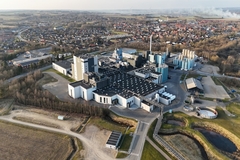
- Industry news
Industry news
- Category news
Category news
- Reports
- Key trends
- Multimedia
- Journal
- Events
- Suppliers
- Home
- Industry news
Industry news
- Category news
Category news
- Reports
- Key trends
- Multimedia
- Events
- Suppliers
Tetra Pak exec: Protein boom, food processing and adapting to industry challenges

Millions of health-conscious consumers face the same dilemma each day: they need more protein, but supermarket product lists are often riddled with unfamiliar names, preservatives, and high levels of salt and sugar. Plant-based proteins offer solutions to the “protein boom,” and the market is set to swell even further.
Academics predict that by 2050, it will be impossible to feed our global population on the current protein-rich diets of North America and Europe.
So, Tetra Pak, a global food-processing and packaging company, believes something needs to change. And as the global demand for protein rises, food processors need to invest in highly efficient equipment that keeps up with the market.

In light of this, Tetra Pak is examining its protein supply chains at a deeper level to see how it can alleviate some of the industry’s wider pressures. Food Ingredients First speaks with a spokesperson from the company, who sheds light on the methods, machinery, and market expansion in this burgeoning sector.
How does the current protein boom present both opportunities and challenges in terms of sustainability in food processing?
Spokesperson: The protein boom reflects the latest step in a long-term shift as consumers seek health-focused and convenient products, from ready-to-drink shakes to fortified foods. That’s a significant opportunity for innovation, expansion, and business growth.
But it comes with challenges. Traditional protein production is resource-intensive, and food systems already account for over a third of global emissions. With the global population predicted to reach 10 billion people by 2050, the opportunity and responsibility is to reimagine how proteins are processed, packaged, and scaled in a way that reduces waste and lowers their environmental footprint.
As a company that provides advanced food production systems, helping producers process and prepare millions of tons of food annually, we are well-positioned to support manufacturers addressing these opportunities.
What new technologies does Tetra Pak have, and how do these contribute to reducing food and ingredient waste?
Spokesperson: Traditional methods of mixing in liquid food production often encounter problems with air entrapment and foaming. Foaming creates an overflow during mixing, leading to expensive product loss and downtime for cleaning, estimated to cost €276,400 (US$325, 600) annually in typical production scenarios. Our Tetra Pak Industrial Protein Mixer addresses this by eliminating excess foaming and trapped air. Annually, this saves up to 44,400 kg of dry matter, avoids product losses estimated at €100,000 (US$118,400), and eliminates 455 hours of cleaning and downtime.
To achieve this, the mixing tank contains smart sensors tailored to the producer’s specific recipe. These sensors detect distinct types of foam and regulate the vacuum effect, accordingly, reducing suction as foam arises. Meanwhile, a purpose-designed dynamic baffle at the base of the mixer controls or even blocks the vortex caused by the mixing tank’s agitators, minimizing air ingress into the mix even if the mixing speed or viscosity changes.
When foaming is addressed, manufacturers benefit from more consistent quality. Reducing foam means additives like de-foaming silicon oil are not required, which not only saves resources, but potentially appeals to the growing number of consumers joining the “cleaner labels” trend for a simpler ingredients list. This is an example of how a technical fix translates directly into sustainability and cost savings while resonating with consumers.
Can you explain how Tetra Pak’s fermentation technology transforms by-products into valuable nutrients and what impact this has on sustainability?
Spokesperson: Fermentation is an exciting avenue for protein production. As part of our approach, we’re exploring how microorganisms can turn sugar streams or food side-products into high-value proteins, fats, and nutrients. Instead of waste, new inputs are generated. This can mean more diverse protein sources, leading to less pressure to feed a growing population by increasing production through the use of farmland. It’s about scaling an approach that’s circular by design, reducing waste while giving people access to safe food.
How does your use of steel technology contribute to reducing carbon emissions, and how scalable is this solution for the plant-based food sector?
Spokesperson: We began using Outokumpu Circle Green stainless steel in our homogenisers in 2024. Homogenisers are crucial to making plant-based drinks smooth, stable, and appealing. By offering homogenisers with a Circle Green stainless steel hood, we provide food and beverage manufacturers with a path to cut their Scope 3 emissions while continuing to take advantage of our equipment’s durability, reliability, and ease of operation.
This low-carbon stainless steel achieves a carbon footprint up to 93% lower than the industry average, around 1.3 tons of CO2 avoided per machine. With approximately 7% of the world’s carbon dioxide emissions stemming from the global steel industry, innovating with renewable energy and optimized processes in stainless steel production has promising potential to help decarbonize production lines, including high-growth categories like plant-based products.
What role do food processing technologies play in addressing rising protein demand and sustainability challenges?
Spokesperson: The plant-based sector is central to the future protein mix. Our technologies are helping make processing more efficient and less wasteful. One example is our whole-bean soya processing, which uses 100% of the bean. Combined with advanced homogenisers and fermentation, the result is products that address sustainability concerns and appeal to consumers. For the industry, it’s about scaling solutions that can meet demand while cutting the environmental footprint of global protein production.
At the same time, it’s essential to recognize that new food is one aspect of the potential solution to meeting protein demand, and that it’s crucial to take a holistic view of protein production. This is why we also address the sustainable transformation of other key protein sources such as dairy.
How are you working with other industry players to create a more sustainable, circular food production system?
Spokesperson: Collaboration is essential. We work extensively with universities, start-ups, NGOs, suppliers, and recyclers. Through our supplier program, over 29 suppliers now have climate targets validated by the Science Based Targets initiative, and we work with 215 recyclers globally to keep packaging in circulation.
We take a holistic approach to circularity, from design to end-of-life. We design recyclable food packaging, increase the use of recycled and renewable materials, and expand collection and recycling to keep materials in use.
In the plant-based sector, we’re helping innovators scale new ingredients and get them to market, efficiently. At Biotech Heights, our innovation hub with Lund University, and the New Food Technology Development Centre in Karlshamn, we bring together science, academia and industry to drive progress on protein diversification. Collaboration is key to creating the circular, resilient food systems we need.










